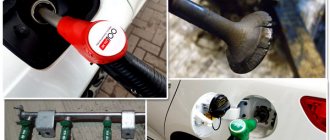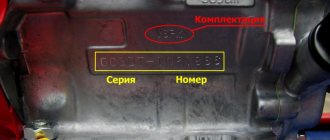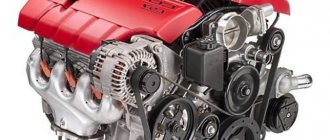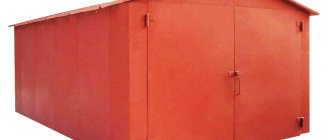The compression ratio is a value that is typical for internal combustion engines. The engine compression ratio is the ratio of the total volume of the cylinder to the volume of the combustion chamber. In other words, it is the ratio of the volume of space above the piston when it is at BDC (bottom dead center) to the volume of the same space above the piston when it is at TDC (top dead center).
It is worth noting that the concept of engine compression ratio is often mistakenly taken as an indicator of compression. Compression is the maximum level of pressure in the cylinder that is created as a result of the piston moving from BDC to TDC. The compression ratio is usually measured in atmospheres, while the compression ratio is expressed mathematically as a certain ratio. An example would be a compression ratio of 11:1.
We also recommend reading the article about what compression is in an engine. In this article you will learn how to measure compression yourself.
In fact, the compression ratio is conditionally the difference in pressure in the combustion chamber between the moment the fuel-air mixture (or only diesel fuel for diesel internal combustion engines) is supplied to the cylinder and the moment when the fuel charge ignites. Different engines may have different compression ratios, depending on the type of motor and its design features. It is customary to distinguish between low and high compression ratios.
What is engine compression ratio
Conventionally, the amount of compression is also represented as the ratio of pressures in the device during the supply of fuel and the explosion of the mixture. This particular degree is determined by the design of the car engine, and can be high or low.
Before the actual process of ignition of the combustible mixture, the pistons compress the fuel to a certain volume. Engineers are able to vary this indicator, calculating it at the design stage. Having learned the quantitative ratio of this value to the volume of the combustion chamber, one can draw various conclusions.
On gasoline power plants, the compression ratio reaches a maximum of 12 units. The higher the engine compression ratio or SSD here, the greater the specific power of the engine. However, with a strong increase in this indicator, the resource of the unit decreases, especially when refueling with low-grade gasoline. On diesel engines, due to their technical differences, it can vary from 14 to 18 units.
In gasoline engines with a compression ratio increased to 12 units, nothing other than AI-98 Premium can be poured. Obviously, this will significantly increase fuel costs.
Drawings for RF patent 2468221
The technical field to which the invention relates is engine construction of gasoline engines.
It is known that when the compression ratio increases, detonation occurs in the engine cylinders. To eliminate this drawback, gasoline with a higher octane number is used. The higher the compression ratio, the higher the octane number of the fuel.
To understand the essence of the invention, it is necessary to understand what happens in the engine during advanced ignition and during late ignition. When the ignition is advanced, detonation occurs, accompanied by knocking in the engine and a sharp increase in exhaust noise. Knocking in the engine appears because the combustion of the charge occurs in a decreasing volume, while the rate of combustion of the charge increases abruptly, and in the same way the volume of gases and the temperature of the gases increase. The combustion of the charge ends before the piston reaches the top TDC. Since the temperature of the gases is increased, the volume of gases is also increased, the speed of gases exiting the cylinder increases, their inertia increases so much that at the end of the exhaust phase, that is, at the moment the intake valve opens, the pressure in the cylinder is significantly lower than the pressure in the intake manifold. Therefore, during the purging time, the flammable mixture of the next charge manages to slip into the exhaust manifold and further into the exhaust system, where, when burned, it sharply increases the exhaust noise and resistance in the exhaust system. With late ignition, combustion occurs in a decreasing volume, but the decrease in volume occurs more slowly, so the combustion of the charge slows down after passing TDC, combustion continues in an increasing volume, and the combustion of the charge slows down even more and can continue during the “exhaust” stroke. At the end of the exhaust phase, the pressure in the cylinder is higher than in the intake manifold, and during the purge period, still burning gases penetrate into the intake manifold and ignite the combustible mixture in the manifold and the engine “sneezes” into the carburetor.
The essence of the idea is that as the compression ratio increases, the charge in the cylinder is heated, and when the charge is heated, the charge burning rate increases, which means the maximum ignition timing is reduced. By reducing the ignition timing, the time of exposure of the flame to the piston bottom, valve plates and combustion chamber walls is reduced, which means less energy will be spent on heating the engine, and more on work, and the higher the compression ratio, the higher the efficiency.
To implement this method of increasing efficiency, it is necessary to stabilize the physical compression ratio throughout the entire life of the engine, since the gaps at the joints on the compression rings during operation increase, which leads to a decrease in the compression ratio by almost 1 unit. over 80-100 thousand km, increasing the ignition timing and increasing fuel consumption. Therefore, in the ZMZ-402 engine, on which the experiments were carried out, a triple compression ring was installed, patent No. 2416749, which stabilizes the compression ratio for at least 100 thousand kilometers and increases the physical compression ratio to 8.3-8.8 without changing the geometric the compression ratio of the cylinder head for A-76 gasoline, with the cylinder head for AI-92 gasoline, the physical compression ratio reached 11.5, after which the experiment was stopped. AI-80 gasoline was used. The engine is installed on a GA3-3110 car.
The essence of the experiment is as follows: new triple compression rings and a block head for AI-92 gasoline were installed on the ZMZ-402 engine. Since the rings were new, not ground in, the physical compression ratio was about 8. During engine operation, the compression rings were ground in and the physical compression ratio increased, but at the same time the engine operated with advanced ignition. Attempts to reduce the ignition timing did not produce a positive result. After this, the ignition timing was set to 0 (the vacuum machine was turned off and the weights of the centrifugal machine were removed), after which the experiment was continued. There was no detonation when the engine was running, but there was increased exhaust noise, as with advanced ignition. Periodically measuring the physical degree of compression, it was not the same in different cylinders, since the rings were ground unevenly. As the rings were worn in, the exhaust noise increased to approximately a compression ratio of 10.2. With a further increase in the compression ratio, the exhaust noise began to decrease, and as the compression ratio approached 11, the engine power began to increase at low loads, and as the load increased, a delayed ignition effect occurred, the engine “sneezed” into the carburetor. Increasing the ignition timing did not produce a positive result. It has been experimentally established that by reducing the resistance of the exhaust system by lengthening the double exhaust pipe, the limit of the effect of advanced ignition expands twice.
Experiments have shown that when increasing the compression ratio, in order to increase engine efficiency, it is necessary to normalize the purge of the combustion chamber, that is, the pressure in the cylinder at the beginning of purge should be slightly lower than the pressure in the intake manifold, at which the remaining exhaust gases leave the combustion chamber, and the fuel the mixture fills the combustion chamber without penetrating into the exhaust manifold. It is impossible to do this on a gasoline engine, but if purging is done not with a combustible mixture, but with air, then there will be no effect of advanced ignition, and there will be no increase in resistance in the exhaust system. In a diesel engine, the combustion chamber is purged with air, and fuel is injected at the end of the compression stroke, so the effect of early ignition does not occur at a compression ratio of 18 and higher. Air purging can be done in a gasoline engine, both carburetor and injection; for this, the engine must have two inlet valves, and there can be one or two exhaust valves - it doesn’t matter.
Figure 1 shows approximate valve timing.
The exhaust phase ends 5 before top dead center. The two intake valves have different valve timing and separate intake ports that are not connected to each other. For one valve—let’s call it air—the intake phase begins 15° before TDC, and for the second gasoline valve, the intake phase begins 5° after TDC. An injector is installed in the inlet channel of the gasoline valve in an injection engine, and in a carburetor engine, a carburetor is connected to the channel of the gasoline valve.
The engine operates as follows.
After the power stroke, the exhaust stroke begins 15° before TDC, the air intake valve opens, the combustion chamber is purged with air, 5° before TDC the exhaust valve or valves, if there are two of them, close, the purging is completed. 5° after TDC, the gasoline valve opens, through which a rich combustible mixture enters the cylinder, and air enters the cylinder through the air inlet valve. In the cylinder, the combustible mixture is mixed with air, forming a combustible mixture of the required proportion of air and gasoline. Next comes the compression stroke, the power stroke and the cycle repeats.
To reduce the resistance of the exhaust system, it is necessary to make a separate exhaust system for each pair of cylinders with synchronously moving pistons. The maximum physical compression ratio for a particular engine can be determined experimentally.
It is possible that in an injection engine a throttle valve will not be needed, and the engine will be controlled only by changing the gasoline supply, that is, by changing the duration of the injection pulse. In this case, the physical compression ratio in all engine operating modes will be maximum, as in a diesel engine.
Technical result: increasing the efficiency of a gasoline engine, and in terms of efficiency it will be closer to a diesel engine.
What does it affect?
SSD directly determines the amount of work produced by the internal combustion engine. The higher the compression ratio is initially calculated, the more productive the ignition will be. The output of the motor will increase proportionally. Let us remember how developers in the 90s tried to increase this figure without completely modernizing the engine. In this way, they competed with each other, making the units more powerful without spending a lot of money. But what’s most interesting is that the engines in this case did not consume more fuel, and even became more economical.
However, there is a limit to everything, and as mentioned above, too high a coefficient leads to a decrease in the life of the internal combustion engine. Why is this happening? The fact is that with significant compression, the fuel mixture begins to spontaneously detonate and explode. This especially affects gasoline-powered units, so here this coefficient has a strict limitation.
Remember that the use of low-octane fuel causes detonation on units with increased SSD. Conversely, high-octane fuel may not allow the engine to fully open if used in units with a low compression ratio. For this reason, both parameters must match. More details in the table below.
Reasons for increasing compression in the engine.
For some time after purchasing the car, the engine runs perfectly, and there is no reason to look under the hood. However, using a car cannot be without problems. And so, the car begins to consume a little more fuel than before. This is the first reason to try to increase the compression.
The second reason for improving the engine is the desire to increase power while maintaining the amount of fuel consumed.
The difference between compression ratio and compression
The compression ratio of an engine is not compression. They are completely different, although many people confuse them. The coefficient discussed in the article does not reveal the value of the optimal fuel assembly pressure before combustion. SSD is measured only relatively, in relation to a unit volume of the chamber.
Compression is usually understood as the limiting value of compression formed in the combustion chamber at the final stage of pressure of the combustible mixture. This value a priori cannot be relative, so it is measured in absolute values - atm, kg/cm2, bar.
Compression ratio and compression are inextricably linked, but not identical. The compression ratio depends not only on compression. It is influenced by the temperature of the internal combustion engine, the presence of gaps in the drive valves, the composition of the fuel and much more.
The higher the compression, the better: the fourth tale
Often, from apologists for various additives, you hear how the compression jumped after the next treatment of the engine. Growth up to 15 bar, up to 17 bar! But we must keep in mind that in normal condition, even after restoring the gaps to the state of a new engine, you will not get compression higher than standard.
Where do the numbers come from? Usually, on a disassembled engine, it is clear that after processing the combustion chamber is overgrown with something unknown and, as a result, the volume of the compression chamber has decreased. But these deposits interfere with heat removal from the combustion chamber. Hence detonation, glow ignition, etc. So we shouldn’t rejoice at the unprecedented increase in compression, but vice versa.
Calculation of compression ratio
Due to the fact that it is desirable to increase the compression ratio to a certain value, it is necessary to be able to calculate this indicator. In addition, this will make it possible to avoid detonation moments that destroy the power unit from the inside during the boost process.
Thus, the need to measure this indicator is required in cases such as:
- engine boost;
- adjustment for fuel with a different AI or for methane fuel with an octane rating of 120;
- post-repair adjustment.
Other engine modifications: intake and exhaust
If you take into account the recommendations of experts, in order for the engine to turn out to be resourceful, you should not strive to increase its volume beyond the 1.6 liter mark. An increase in volume above this figure will mean that the engine becomes “heavier” and spins less intensively.
As for modifications, special attention should be paid not only to the block, but also to the cylinder head. The modification involves grinding the cylinder head channels through which fuel flows from the intake manifold. It is important to achieve not only a larger channel cross-section, but also a smooth transition, and also that all channels end up being the same.
The next step will be to upgrade the exhaust ports and valves. The channels are polished and the valves can even be replaced. For example, a suitable option is selected (it can also be from a foreign car), after which the valve stems are processed to the dimensions for a VAZ engine.
We also recommend reading the article about whether it is possible to install a turbine on an engine with a carburetor. From this article you will learn about the features and nuances of installing a turbocharger on a carburetor engine.
The valve plates should also be processed at the same time. It is important to adjust all valves according to weight. Separately, it is worth approaching the issue of installing the camshaft. In order for the engine to pull well from the bottom and at high speeds, it is optimal to select a camshaft that provides high valve lift. At the same time, a split gear is also required for precise adjustment of the valve timing.
Turbocharged engines
On turbo engines, the calculation of the compression ratio is different. This is due to the presence of air pressure. Therefore, in this case, the value obtained during the calculations is multiplied by the turbocharger indicator.
In addition, when calculating the compression ratio of turbocharged engines, not only the boost pressure is taken into account, but also the effective compression indicator, climate changes and much more. In this case, the process becomes significantly more complicated compared to measurements on an atmospheric engine.
And it’s not a fairy tale at all.
So what does compression do? For a lot! The main thing is the starting properties of the motor, especially at low temperatures.
This primarily applies to diesel engines, where the pressure and temperature at the end of compression determine whether the fuel in the cylinder will ignite or not. But gasoline engines in a cold state are also sensitive to changes in compression: it affects the volatility of the fuel, which, during a cold start, should only theoretically evaporate on the way to the cylinder. But in reality, it gets there in the form of non-flammable liquid drops.
Reduced compression increases crankcase gas pressure. In this case, a larger volume of oil vapor flies through the ventilation system to the engine inlet. This is bad: toxicity increases, and the rate of combustion chamber contamination increases sharply.
Uneven compression across the cylinders causes engine vibrations, especially noticeable at idle and at low speeds. And this, in turn, harms both the transmission and the engine suspension. And to the driver himself.
In short, the role of compression as a diagnostic sign, largely characterizing the condition of the engine, is very great. And our “fairy tales” in no way call for giving up on her - on the contrary! But the desire for an unbridled increase in it in search of additional “horses” is generally futile.
Make your life easier and brighter
Counting example
This is what the generally accepted calculation formula for an automobile internal combustion engine looks like: “SSD = (RO+OKS)/OKS.” The compression ratio here is o, the working volume of the cylinder is “RO”, and the volume of the combustion chamber is “OKS”.
To calculate “PO,” you must first decompose the single engine volume or displacement into the number of cylinders used. For example, the displacement of the “four” engine is 1997 cm3. To determine the capacity of one cylinder, you need to divide 1997 by 4. You get about 499 cm3.
To calculate the “OCS” parameter, specialists use a tube or pipette calibrated in cm3. The chamber refers to the place where the fuel ignites directly. The chamber is primed and then the volume is measured using a liquid burette. If you don't have a graduated tube, you can pump out the liquid with a syringe and then measure it in a measuring cup or on a scale. In this case, it is advisable to use clean water for calculations rather than gasoline or diesel fuel, since its specific gravity is more related to the volume in cm3.
Attention! To accurately measure “OKS”, the thickness of the cylinder head gasket is additionally added, the shape of the piston crown and other features are taken into account. Therefore, it is recommended to entrust the calculation of this value to specialists.
How to measure compression
Unlike compression ratio, measuring engine compression is not particularly difficult. To carry out this work, it is enough to have a compressometer or compressograph.
The operating principle of these two devices is the same, the only difference is in the output of information.
With a compression gauge, the pressure value is indicated on the pressure gauge scale.
With a compressograph, information about the pressure in the cylinder is recorded on some storage medium or simply on paper.
The sequence for checking compression in a diesel engine is as follows:
- The injector is removed from one cylinder and a device is installed in its place;
- Then the crankshaft is cranked with the starter and the result is recorded;
- Then the compression in all other cylinders is checked;
- Then the values obtained in all cylinders are compared.
For an unworn engine, the compression should match or at least be close to the nominal value specified in the documentation. The difference in performance on different cylinders should also be the same, minor differences are allowed.
How to increase engine compression ratio
If you need to increase this indicator, use several methods:
- boring the block and installing pistons with a large diameter;
- reducing the volume of the combustion chamber by removing the metal layer at the cylinder head connection.
We must not forget that in some cases the installation of upgraded pistons will be required. This is done to eliminate such an undesirable consequence as the pistons meeting the valves. In particular, the valve recesses on the elements are increased. Also, the valve timing must be adjusted again.
Interestingly, Japanese manufacturers have revealed the potential of internal combustion engine compression ratios best of all. While European auto companies went the route of improving hybrid engines, the Japanese managed to increase the SSD to 14 units on gasoline power units, using a variable value. But how is this possible without detonation moments? Everything turned out to be simple. It turns out that you need to cool the chamber where the fire occurs. Then you can safely compress the mixture. And it is not at all necessary to use cool air for this: it is enough to modernize the exhaust system.
A technique that has long been known from racing engines. The exhaust channels are changed according to the 4-2-1 scheme. Portions of exhaust gases do not interfere here; they fly out one by one into the chimney. Thanks to such a clear exhaust system, the purging of the cylinders is improved, where less hot gases remain.
The secret of the Japanese formula, according to which you can safely compress a combustible mixture, has a strictly mathematical relationship. So, if the exhaust percentage is reduced by 2 times, the SSD can be raised by 3 units, but no more. If you also cool the air entering the cylinders, you can add one more unit.
However, to implement this method, it will be necessary to modernize the gas exchange by forking out for phase shifters of both camshafts. In addition, some aspects will need to be improved. For example, changing the length of the piston stroke through computer intervention.
A variable coefficient system is used on many Japanese engines, for example, for Inflniti. The ability to automatically change this compression ratio depending on the load can significantly increase the efficiency of the engine, especially a turbocharged one. Each portion of the mixture burns at the optimal compression at the moment. So, if the load on the engine is insignificant and the mixture is lean, maximum compression is turned on. Conversely, in loaded mode, the minimum degree is used, since a lot of gasoline is injected and detonation is possible.
Thus, the advanced system for changing the SSD makes it possible to halve the engine displacement, while maintaining power and dynamic characteristics.
A trend towards increasing the engine compression ratio was also observed in the mid-20th century in the USA. The bulk of American engines produced in the 70s were in the range of 11-13 units. But they only worked on very high-quality, high-octane fuel obtained by leading. After leading was banned, a decrease in the compression ratio was observed in serial samples of internal combustion engines.
It is important to know that the increase in power will be most noticeable on engines that normally operate at a low compression ratio. For example, engines with an indicator of 8 units, increased to 10, will produce more power than units with a stock parameter of 11 units, boosted to 12.
Stories from our readers
“Fucking basin. "
Hi all! My name is Mikhail, now I’ll tell you a story about how I managed to exchange my two-wheeler for a 2010 Camry. It all started with the fact that I began to be wildly irritated by the breakdowns of the two-wheeler, it seemed like nothing serious was broken, but damn it, there were so many little things that really started to irritate me. This is where the idea arose that it was time to change the car to a foreign car. The choice fell on the melting Camry of the tenth years.
Yes, I had matured morally, but financially I just couldn’t handle it. I’ll say right away that I am against loans and taking a car, especially not a new one, on credit is unreasonable. My salary is 24k a month, so collecting 600-700 thousand is almost impossible for me. I started looking for different ways to make money on the Internet. You can’t imagine how many scams there are, what I haven’t tried: sports betting, network marketing, and even the volcano casino, where I successfully lost about 10 thousand ((The only direction in which it seemed to me that I could make money was currency trading on the stock exchange, they call it Forex. But when I started delving into it, I realized that it was very difficult for me. I continued to dig further and came across binary options. The essence is the same as in Forex, but it’s much easier to understand. I started reading forums, studying trading strategies. I tried it on a demo account, then opened a real account. To be honest, I didn’t manage to start earning money right away, until I understood all the mechanics of options, I lost about 3,000 rubles, but as it turned out, it was a precious experience. Now I earn 5-7 thousand rubles a day. I managed to get the car buy after half a year, but in my opinion this is a good result, and it’s not about the car, my life has changed, I naturally quit my job, I have more free time for myself and my family. You’ll laugh, but I work directly on the phone)) If If you want to change your life like me, then here’s what I advise you to do right now: 1. Register on the site 2. Practice on a Demo account (it’s free). 3. As soon as you get something on the Demo account, top up your REAL ACCOUNT and go to REAL MONEY! I also advise you to download the application to your phone, it’s much more convenient to work from your phone. Download here.
Table of approximate increase in engine power with increasing compression ratio:
| Increasing the compression ratio | Increase in engine power |
| from 8 to 9 | 2,0% |
| from 9 to 10 | 1,7% |
| from 10 to 11 | 1,5% |
| from 11 to 12 | 1,3% |
| from 12 to 13 | 1,2% |
| from 13 to 14 | 1,1% |
| from 14 to 15 | 1,0% |
| from 15 to 16 | 0,9% |
| from 16 to 17 | 0,8% |
Intermediate results are summed up, for example, raising the compression ratio from 8 to 14 will give an increase of 8.7%.
Table: compression ratio and octane number of gasoline. Approximate dependence.
| Compression ratio | Petrol |
| from 9 to 10.5 | AI 92 |
| from 10 to 12.5 | AI 95 |
| from 12 to 14.5 | AI 98 |
Engine depowering: why it is needed and how to do it
Sometimes it is necessary to reduce the compression ratio. In this case, an additional metal cylinder head gasket is installed. You can use two gaskets instead of one, thereby thickening the gap - the volume of the chamber increases due to the height of the block head. A more complex method involves shortening the piston - removing the top layer on a lathe.
Engine depowering is usually a forced procedure. This is done, among other things, to reduce tax payments or to increase the resource of the unit. As you know, engines with a low compression ratio last longer and are less susceptible to wear. However, any such process is complicated by law to prevent unscrupulous owners from artificially lowering technical data.
As for reducing the compression ratio on turbocharged engines, it will require upgrading the electrical system with sensors, the entire piston group and injectors if it is a diesel unit.
In some cases, a swap is preferred to depowering, when a less powerful contract motor is installed instead of a standard one.
No compression - straight to capital: the third tale
Typically, a mechanic who discovers low compression immediately declares: “The engine is worn out and needs some capital.” Is everything so clear?
Of course not! For argument's sake, we can name twenty possible reasons for decreased compression. There are problems with the gas distribution mechanism, mechanical or thermal damage to engine parts, and coking of the piston rings. And only one of them will be associated with catastrophic wear of the engine. It is important to be able to distinguish between these causes, understand the degree of their danger and know methods to combat them. But this is a topic for a separate article.











